Introduction
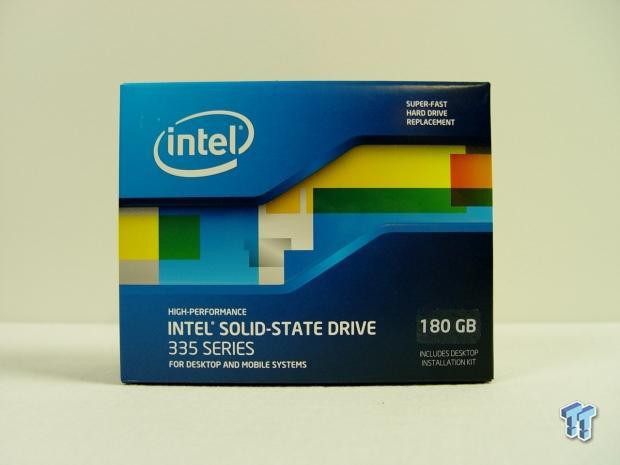
Over the last three months we back tracked and covered 128GB class SSDs after all but dismissing their existence for nearly a year. After installing Windows 8 on a SuperSSpeed S301 SLC 120GB SSD, I think it was a mistake. Windows 8, like every version of Windows before it, takes more space than its predecessor used. As we're shown in the past, SSDs slow in a linier fashion to the amount of data on the flash. Knocking out half the storage capacity with your OS and Office isn't a good way to start out with your new SSD, because it also means nearly half of your performance goes with it.
The 180GB capacity size isn't rare, but not every company builds products in this capacity size. For the most part, when you see a 180GB product, 90GB as well, a LSI SandForce controller is involved. That's exactly what Intel used on the 335 Series, but unlike previous Intel SSDs, the 335 uses new Intel 20nm NAND flash.
This is our second look at the 335 Series. We tested the 240GB model when the series first hit the market and found its performance was better than the 330 Series and really liked the notebook battery life.
Let's take a look at the 180GB part now.
Specifications, Pricing and Availability
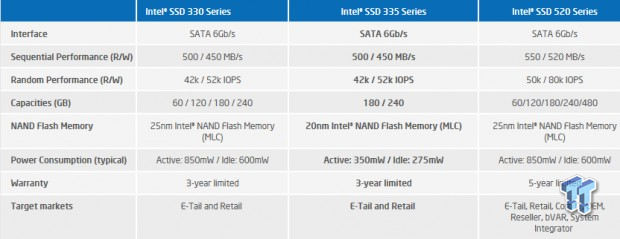
The consumer 2.5" lineup from Intel consists of the 330 Series, 335 Series and 520 Series. The newest to the lineup is the 335 Series and Intel only offers it in 180GB and 240GB. 335 is also the only family in the current lineup using new 20nm NAND flash.
In the first quarter of 2013 Intel sold twice the number of SSDs than they did in Q1 2012. The company estimates this growth will continue throughout the year, but 25nm flash alone isn't enough to double output. There is already a shortage of 520 Series products and Intel needs 20nm flash, thus 335 Series to fill in gaps. Intel Micron Flash Technology can produce more NAND per wafer with 20nm and that eases pressure on 25nm destined for enterprise and professional products.
Intel' specifications show nearly identical performance between the 330 Series and 335 Series. We felt the 335 was a little faster in 240GB when we tested it a few months ago, but that may have been due to further firmware improvements. The big difference between 330 and 335 on the chart above is power consumption. The Intel 335 uses less than half the power of the 330 and 520 Series and lower power consumption is good for notebook users.
In a surprising move, Intel didn't design the new 335 for use in their own Ultrabook market. The 335 Series has a z-height of 9.5mm or a traditional notebook size. Many of the new Ultrabooks require 7mm SSDs so this is a move we don't agree with. Your existing notebook is still fair game and desktops as well.
Newegg lists the 335 Series at $174.99 (180GB) and $209.99 (240GB). The 335 ships with a nice accessory kit that includes a software disk (with the Intel SSD Toolbox and Intel Data Migration), desktop adapter bracket, SATA power, SATA data cables, screws for mounting the drive, a sticker and a quick installation guide. The 335 Series also has a three year warranty.
Packaging
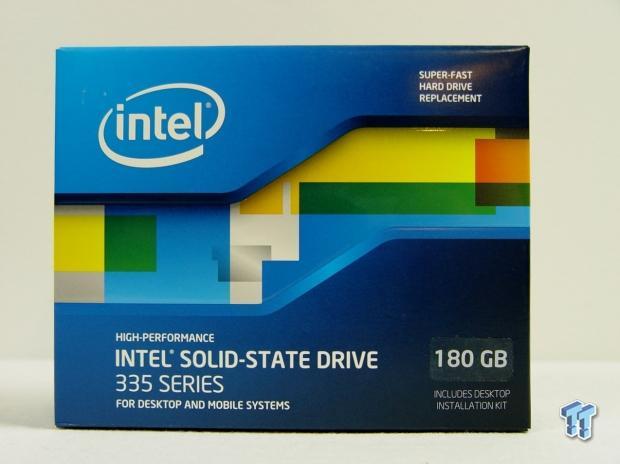
The 335 Series ships in a full retail package that doesn't look much different than Intel's processor package.
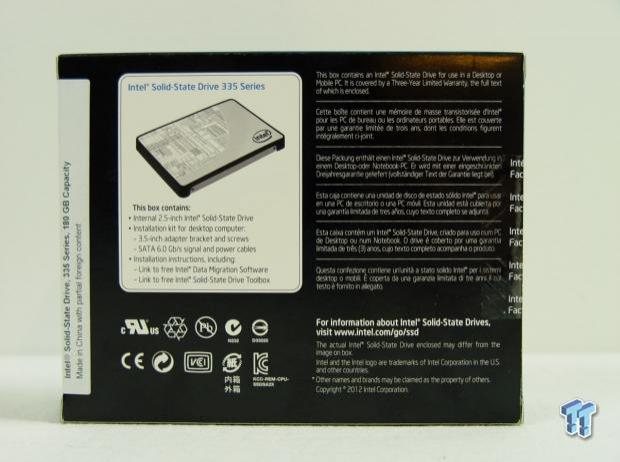
The back of the package gives us a description of the drive, what's included in the package and some specifications.

All of the accessories are tucked away from the SSD so your drive won't be damaged during shipping.

Here we see the accessories laid out.
Intel 335 Series 180GB SSD

The case is all metal like many of Intel's other SSDs.
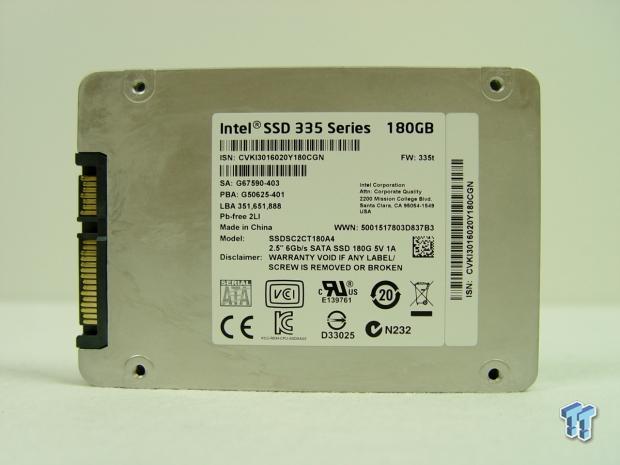
Unlike some of Intel's other SSDs, the label is on the backside of the drive.

As we mentioned earlier in the review, 335 Series uses a 9.5mm case so some new ultrabook products are not compatible.
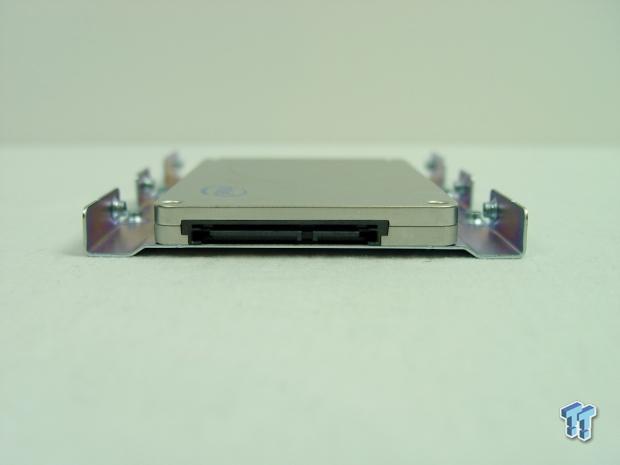
The SATA power and data connections are located where they should be, but Intel's included desktop adapter bracket does not offset the drive.
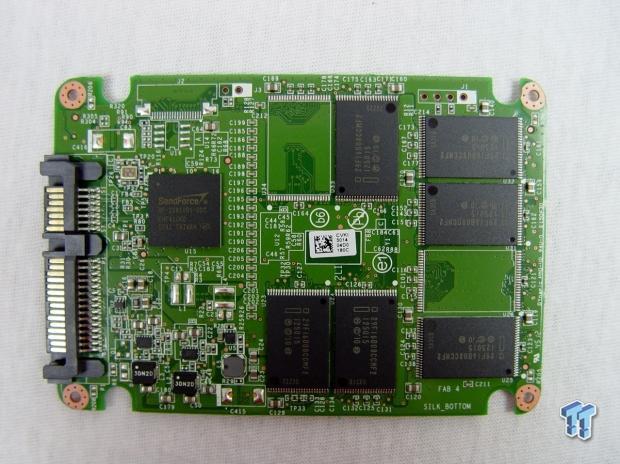
To get to the 180GB capacity size, Intel built the 335 Series 180GB drive with only 12 NAND flash chips, instead of the 16 found on the 240GB model.

The reduction was made by removing two chips on each side.
Benchmarks - Test System Setup and ATTO Baseline Performance
Desktop Test System
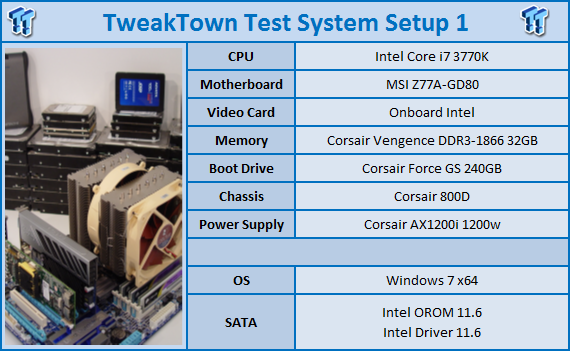
Lenovo W530 - Mobile Workstation
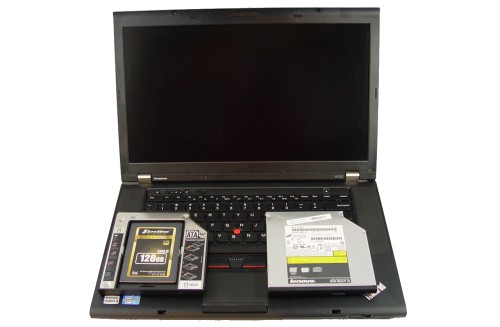
We use two systems for SSD testing. The desktop runs a majority of the tests and the Lenovo W530 runs the notebook power tests as well as the real-world file transfer benchmark.
ATTO Baseline Performance
Version and / or Patch Used: 2.34
ATTO is used by many disk manufacturers to determine the read and write speeds that will be presented to customers.
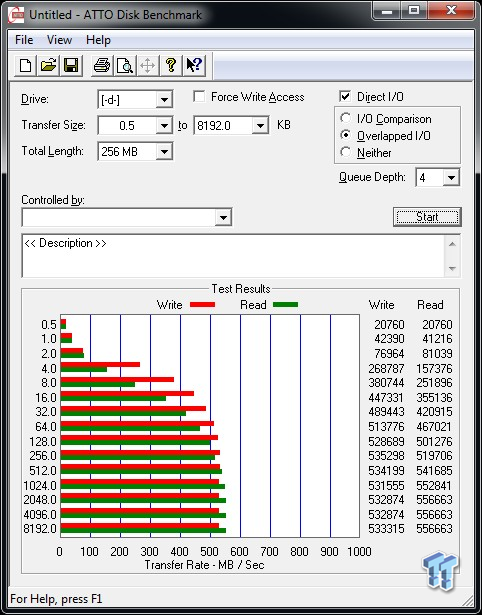
The 335 Series 180GB delivered 556 MB/s read performance in ATTO and 533 MB/s write. These are best case numbers with the test ran at a queue depth of four.
Benchmarks - Sequential Performance
HD Tune Pro
Version and / or Patch Used: 4.00
Developer Homepage: http://www.efdsoftware.com
Product Homepage: http://www.hdtune.com
HD Tune is a Hard Disk utility which has the following functions:
Benchmark: measures the performance
Info: shows detailed information
Health: checks the health status by using SMART
Error Scan: scans the surface for errors
Temperature display
HD Tune Pro gives us accurate read, write and access time results and for the last couple of years has gained popularity amongst reviewers. It is now considered a must have application for storage device testing.
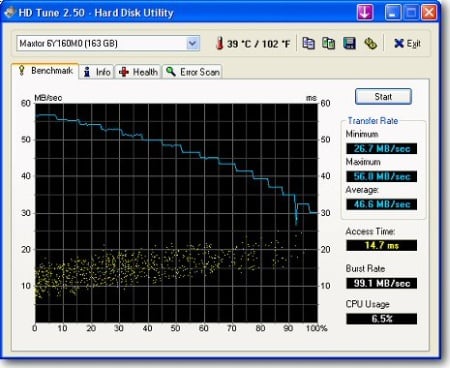
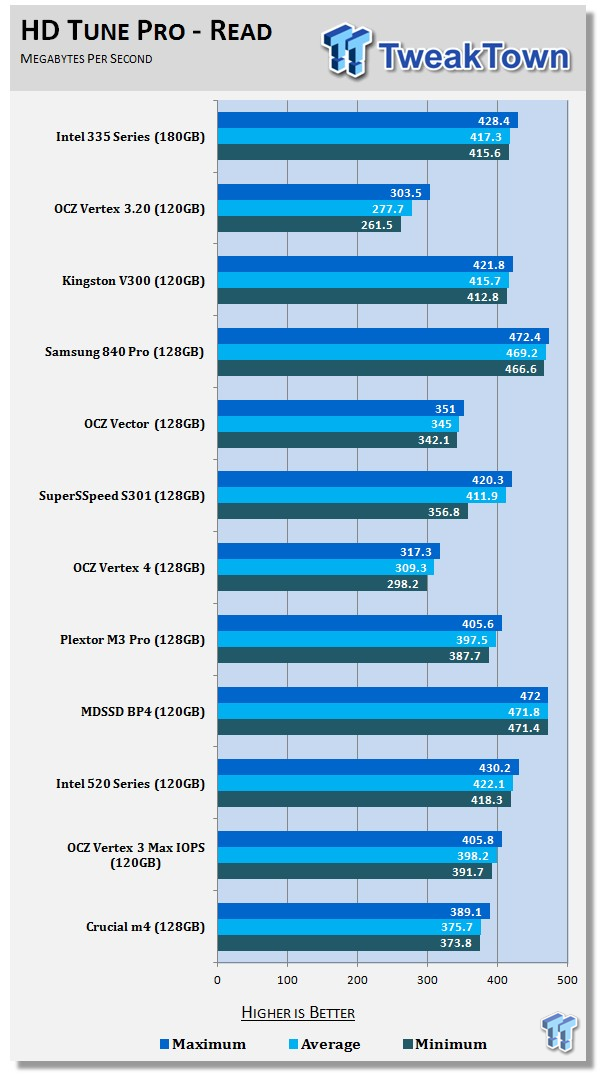
The Intel 335 Series can look really good when compared to 128GB capacity sizes SSDs and just average when compared to 240GB drives. There just aren't enough 180GB products on the market to build charts for this capacity size. Since we want to show the 335 Series 180GB as an alternative to 128GB drives we chose to use our 128GB charts.
Starting with a fresh drive we achieved 417 MB/s sequential read performance with the 335 Series 180GB.

Write performance will increase by a large margin when compared to most 120GB SSDs based on SandForce controllers. This is especially true for new 19nm and 20nm drives on the market. Here we see the 335 writing faster than Samsung's 840 Pro.
HD Tach - Sequential Write Performance after Random Writes

The larger capacity sized means the drive takes longer to use the flash and get to a true consumer steady state. TRIM and garbage collection work to keep performance high, but both countermeasures need time to work.
Benchmarks - AIDA64 Random Access Time
AIDA64 Random Access Time
Version and / or Patch Used: 1.60
Developer Homepage: http://www.aida64.com
Product Homepage: http://www.aida64.com
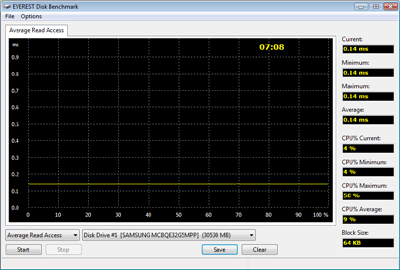
AIDA64 offers several different benchmarks for testing and optimizing your system or network. The Random Access test is one of very few if not only that will measure hard drives random access times in hundredths of milliseconds as oppose to tens of milliseconds.
Drives with only one or two tests displayed in the write test mean that they have failed the test and their Maximum and possibly their Average Scores were very high after the cache fills. This usually happens only with controllers manufactured by Jmicron..

Without a DRAM buffer for storing page table data, the 335 Series has a little higher access time than products with DRAM. The 180GB 335 does better than many of the new 240GB drives with SandForce controllers.
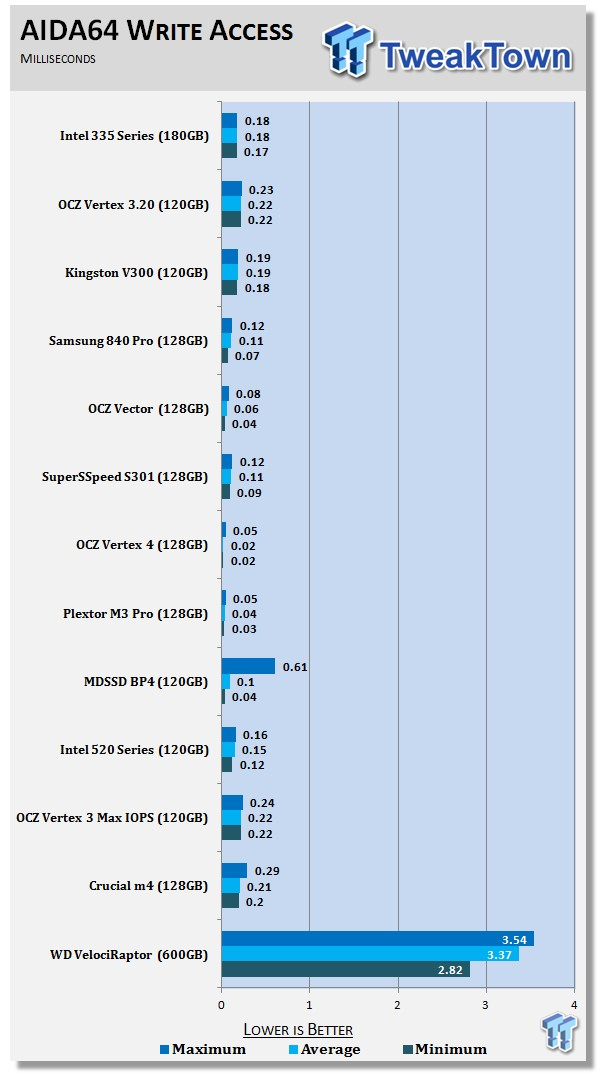
The 335 180GB didn't produce any unreasonable outlier latency in our test.
Benchmarks - Anvil Storage Utilities
Anvil Storage Utilities
Version and / or Patch Used: RC6
So what is Anvil Storage Utilities? First of all, it's a storage benchmark for SSDs and HDDs where you can check and monitor your performance. The Standard Storage Benchmark performs a series of tests, you can run a full test or just the read or the write test or you can run a single test, i.e. 4K DQ16.
Anvil Storage Utilities is not officially available yet but we've been playing with the beta for several months now. The author, Anvil on several international forums has been updating the software steadily and is adding new features every couple of months.
The software is used several different ways and to show different aspects for each drive. We've chosen to use this software to show the performance of a drive with two different data sets. The first is with compressible data and the second data set is incompressible data. Several users have requested this data in our SSD reviews.
0-Fill Compressible Data
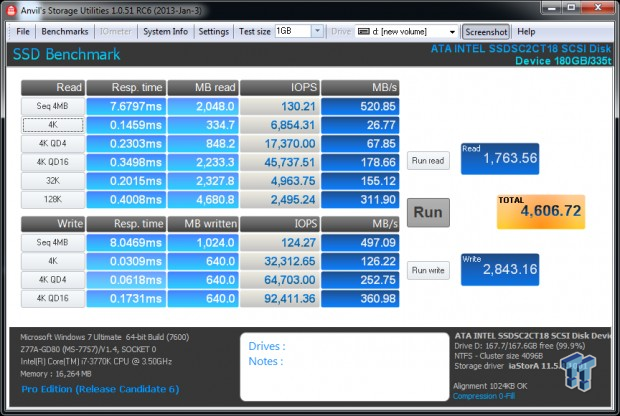
Incompressible Data

The LSI SandForce controller works with incompressible data differently than compressible data since the controller compresses data before storing it on the flash. Here we see the performance loss when moving from one data type to another.
Read IOPS through Queue Depth Scale
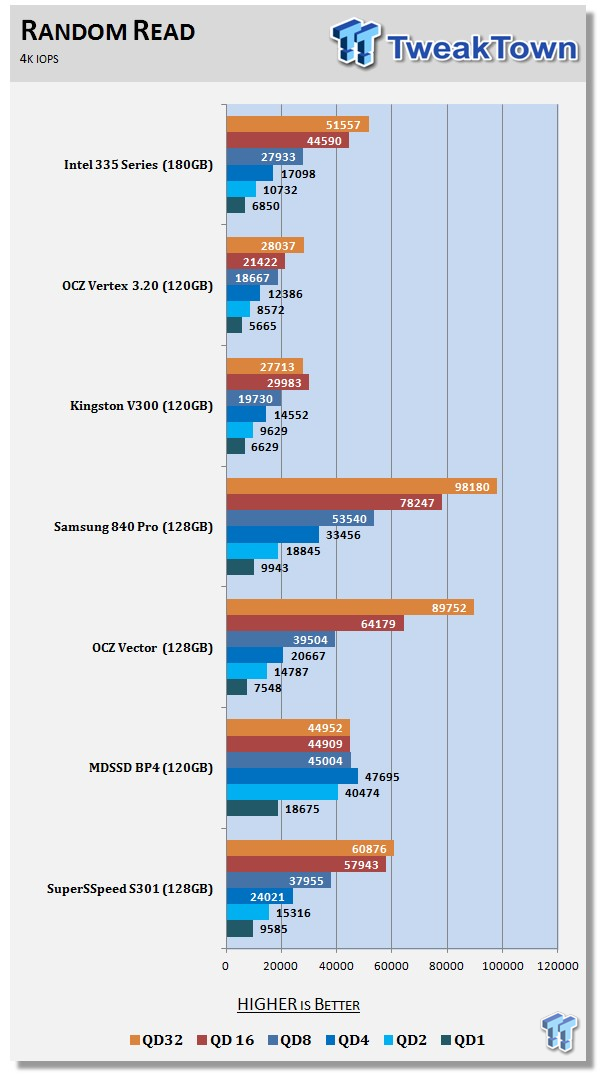
As we mentioned in the article, the 180GB capacity size is faster than the SandForce 120GB drives with MCL on the market. Here we start to see the performance difference and where the smallest 335 Series drive starts to overtake the new Vertex 3.20 and V300, both SandForce controlled drives. You can also see how the 335 compares to the two hyper SSDs on the market today - the OCZ Vector and Samsung 840 Pro.
Scaling Write IOPS through Queue Scale

The 4K write IOPS performance also shows where QD2 and QD4, both very important for daily use, are much faster on the 180GB capacity size 335.
Benchmarks - CrystalDiskMark
CrystalDiskMark
Version and / or Patch Used: 3.0 Technical Preview
Developer Homepage: http://crystalmark.info
Product Homepage: http://crystalmark.info/software/CrystalDiskMark/index-e.html
Download here: http://crystaldew.info/category/software/crystaldiskmark
CrystalDiskMark is a disk benchmark software that allows us to benchmark 4K and 4K queue depths with accuracy.
Key Features:-
* Sequential reads/writes
* Random 4KB/512KB reads/writes
* Text copy
* Change dialog design
* internationalization (i18n)
Note: Crystal Disk Mark 3.0 Technical Preview was used for these tests since it offers the ability to measure native command queuing at 4 and 32.

In CDM we see incompressible data that ranges from sequential to random at high queue depths. The 335 Series 180BG breaks into the 25MB/s arena in 4K reads. After testing Vertex 3.20 we worried about the performance 20nm IMFT flash would deliver, but it looks acceptable now.
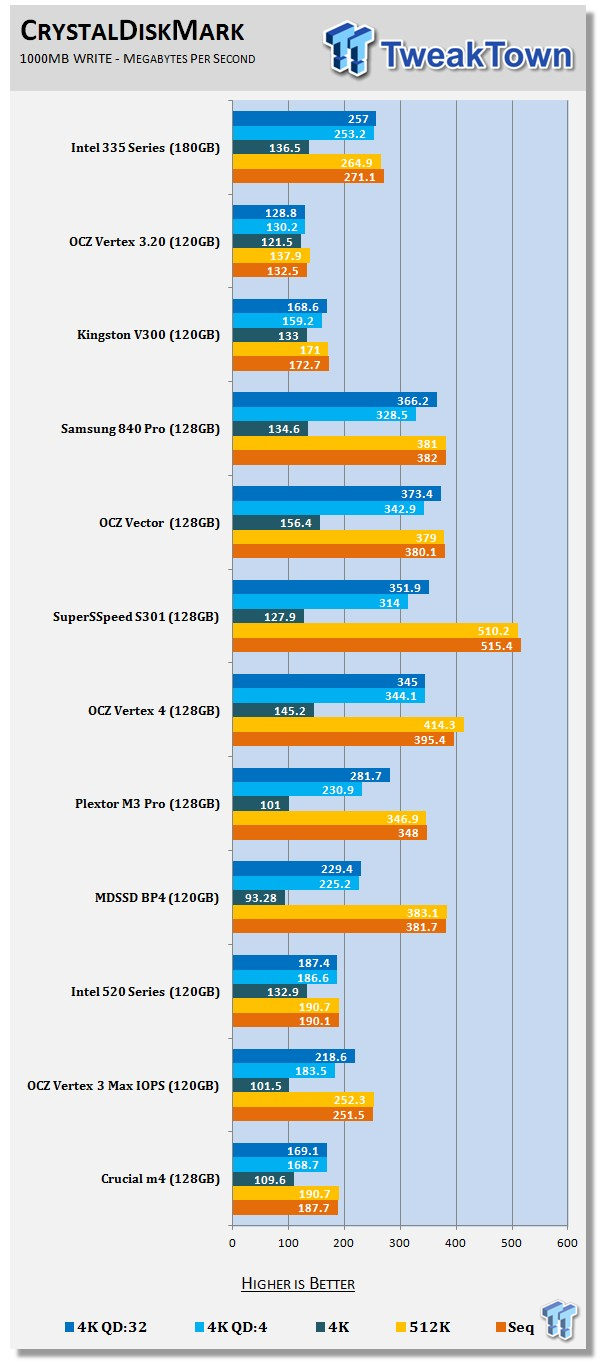
In the past we've spoken about the brick wall of performance that comes with 128GB SandForce drives. You can see the effect on the chart, the Vertex 3.20 and V300 directly under the 335 Series 180GB. There are many reasons to choose the Intel 335 180GB over a 120GB SandForce drive, and these results send a clear picture.
Benchmarks - PCMark Vantage Hard Disk Tests
PCMark Vantage - Hard Disk Tests
Version and / or Patch Used: 1.0.0
Developer Homepage: http://www.futuremark.com
Product Homepage: http://www.futuremark.com/benchmarks/pcmark-vantage/

PCMark Vantage is the first objective hardware performance benchmark for PCs running 32 and 64 bit versions of Microsoft Windows Vista. PCMark Vantage is perfectly suited for benchmarking any type of Microsoft Windows Vista PC from multimedia home entertainment systems and laptops to dedicated workstations and high-end gaming rigs. Regardless of whether the benchmarker is an artist or an IT Professional, PCMark Vantage shows the user where their system soars or falls flat, and how to get the most performance possible out of their hardware. PCMark Vantage is easy enough for even the most casual enthusiast to use yet supports in-depth, professional industry grade testing.
FutureMark has developed a good set of hard disk tests for their PCMark Vantage Suite. Windows users can count on Vantage to show them how a drive will perform in normal day to day usage scenarios. For most users these are the tests that matter since many of the old hat ways to measure performance have become ineffective to measure true Windows performance.

HDD1 - Windows Defender
HDD2 - Gaming
HDD3 - Windows Photo Gallery
HDD4 - Vista Startup
HDD5 - Windows Movie Maker
HDD6 - Windows Media Center
HDD7 - Windows Media Player
HDD8 - Application Loading
In all the tests so far we've looked at targeted areas of performance, corner cases that you wouldn't see under normal use. The rest of the article uses real world benchmarks that show performance in your system. Here we see eight daily use programs and tasks courtesy of PCMark Vantage.
As you can see, real world performance brings the drives closer together. Files systems, background tasks and other bottlenecks get in the way. On the other side of that coin, SSD programming and tuning can make a drive with less desirable corner case performance feel faster in real world use. The Intel 335 Series 180GB does well in real world, daily use tasks. In some of the tests, it's faster than the Samsung 840 Pro and OCZ Vector.
Benchmarks - PCMark Vantage - Drives with Data Testing
For a complete breakdown on the Drives with Data Testing please read this article. You will be able to perform this test at home with the files provided in the article - full instructions are included.
- Brief Methodology
SSDs perform differently when used for a period of time and when data is already present on the drive. The purpose of the Drives with Data testing is to show how a drive performs in these 'dirty' states. SSDs also need time to recover, either with TRIM or onboard garbage collection methods.
Drives with Data Testing - 25%, 50%, 75% Full States and Dirty / Empty Test
Files needed for 60 (64GB), 120 (128GB), 240 (256GB)
60GB Fill - 15GB, 30GB, 45GB
120GB Fill - 30GB, 60GB, 90GB
240GB Fill - 60GB, 120GB, 160GB
Empty but Dirty - a test run just after the fill tests and shows if a drive needs time to recover or if performance is instantly restored.

SSDs slow as data populates the flash. The more data, the slower the drive and we've seen some drives get very slow over the years.
Using the 50% of capacity as the market, the 335 Series 180GB performs well here, but you can also see why Intel positions the 520 Series over the 335. The 520 Series 120GB still has the best 50% full performance of any other SSD we've tested to date.
Benchmarks - BootRacer
BootRacer - System Boot Time
Version and / or Patch Used: 4.0
Developer Homepage: Greatis
Product Homepage: BootRacer
Download here: http://www.greatis.com/bootracer/download.htm
Note: In this test we use the Lenovo W530 Mobile Workstation loaded with an operating system and several program files. The data on the drive at the time of the test is 45GB. The second test, 50GB Free, was ran with the drives filled with block data until only 50GB of free capacity remained.
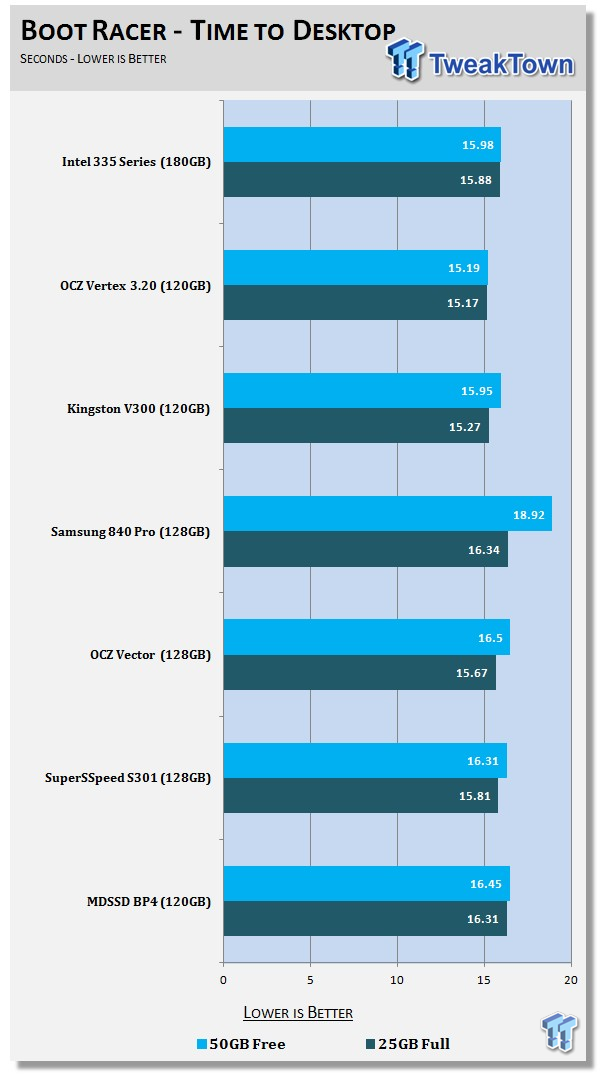
In our Lenovo W530 we get to see how long it takes to restart the computer.
We've had a few questions about this test with some asking why the computer takes so long to turn on. This is a restart test where the W530 shuts down from the desktop and comes back to the desktop.
Benchmarks - DiskBench
DiskBench - Directory Copy
Version and / or Patch Used: 2.6.2.0
Developer Homepage: Nodesoft
Product Homepage: DiskBench
Download here: http://www.nodesoft.com/diskbench/download
Note: In this test we use the Lenovo W530 Mobile Workstation and a SuperSSpeed S301 SLC 128GB SSD to move a 15GB block of data to and from the target drive. This is part of our real world test regiment. Roughly 45GB of data resides on the target drive before the '15GB Block' is transfer. The 15GB Block is the same data we built for the Data on Disk Testing and is a mix of compressible and incompressible data.

The extra write performance we observed in the corner case tests comes through in the real-world directory copy test. Just below the 335 Series are two new SandForce based 120GB drives.
The extra performance from the larger capacity shines through when comparing drives based on SandForce controllers. Other architectures have caught up to SandForce though, especially in the lower capacity sizes.
Benchmarks - Power Testing
Bapco MobileMark 2012 1.5
Version and / or Patch Used: 2012 1.5
Developer Homepage: http://www.bapco.com
Test Homepage: http://www.bapco.com
MobileMark 2012 1.5 is an application-based benchmark that reflects usage patterns of business users in the areas of office productivity, media creation and media consumption. Unlike benchmarks that only measure battery life, MobileMark 2012 measures battery life and performance simultaneously, showing how well a system design addresses the inherent tradeoffs between performance and power management.

For the last couple of months we've tested a handful of new B02 stepping SandForce drives. Intel with their high quality voltage regulators and new 20nm NAND achieve near B02 battery life levels. For a majority of the test, the 335 Series ran right with the new Phison controlled MyDigitalSSD BP4, one of the best drives we've come across for this test.
PCMark Vantage HDD Test - Power Draw

Here we see the secret to the 335's battery life success - very low idle power. It doesn't end there though, on the chart we see the power draw when reading and writing data to the drive and the 335 does well across the chart.
The 20nm NAND isn't solely responsible for the low power because the OCZ Vertex 3.20 (yellow trace) also uses 20nm Intel flash.
Final Thoughts
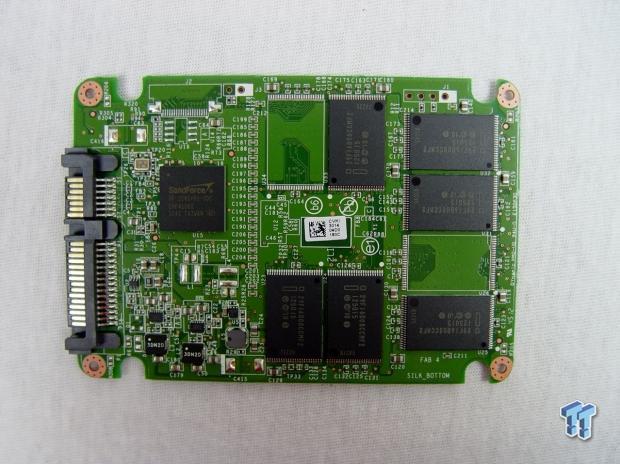
When we go shopping for computer parts, we rarely point to a specific product and say that's the model I want and I'm going to save up until I can buy it. The process generally starts out a bit different and based on what's free in our bank account. I have $100, $200 or $300 and I'm going to buy a new SSD or a new SSD and RAM or whatever we are trying to group together on the same receipt. 256GB class SSDs are on many wish lists, but the financials don't always pan out.
At $174.99, the Intel 335 Series 180GB brings 240GB performance down to more affordable levels. There are a few 240GB SandForce based drives at around the same price, but many of those use asynchronous NAND and are much slower than the Intel 335 Series. Compared to 128GB class drives, the Intel 335 180GB costs a bit more, but offers more capacity and compared to other LSI SandForce 120GB drives, delivers better performance.
The 335's most impressive feature is the low power consumption. Intel managed to reduce both idle and active power by more than half over both the 520 and 330 Series. When we first reviewed the 335 Series 240GB, we thought the lower power consumption was a direct result of the 20nm flash, but now that we've seen other SandForce drives with 20nm, we know it was more than just the flash.
For the last six months we spent a lot of time studying the power consumption results and talking with engineers about what effects power consumption. Not all SSDs are created equally and you can't lump all Marvell, all SandForce, or all LAMD drives together. On the chart today we saw the OCZ Vertex 3.20, another drive using Intel 20nm flash and it uses more power than the 335 Series. We've learned that the other components, such as the unnamed surface mount components, also play a large role in power consumption. Intel obviously uses higher quality, or at least more efficient components, than many of the other companies.
This doesn't surprise us and it shouldn't surprise our readers either. In many cases Intel products cost more than competitors and the blanket statement has always been more compatibility, more reliability, more validation and higher quality components. It isn't often we can show component quality or efficiency, but with SSDs we can. SSDs also allow us to see how more efficient components affect real-world use.

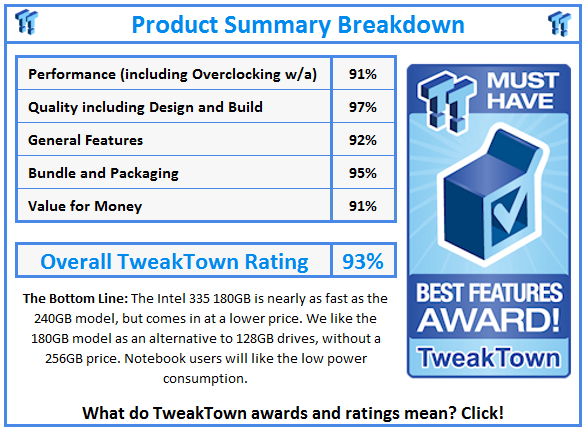
 United
States: Find other tech and computer products like this
over at
United
States: Find other tech and computer products like this
over at  United
Kingdom: Find other tech and computer products like this
over at
United
Kingdom: Find other tech and computer products like this
over at  Australia:
Find other tech and computer products like this over at
Australia:
Find other tech and computer products like this over at  Canada:
Find other tech and computer products like this over at
Canada:
Find other tech and computer products like this over at  Deutschland:
Finde andere Technik- und Computerprodukte wie dieses auf
Deutschland:
Finde andere Technik- und Computerprodukte wie dieses auf